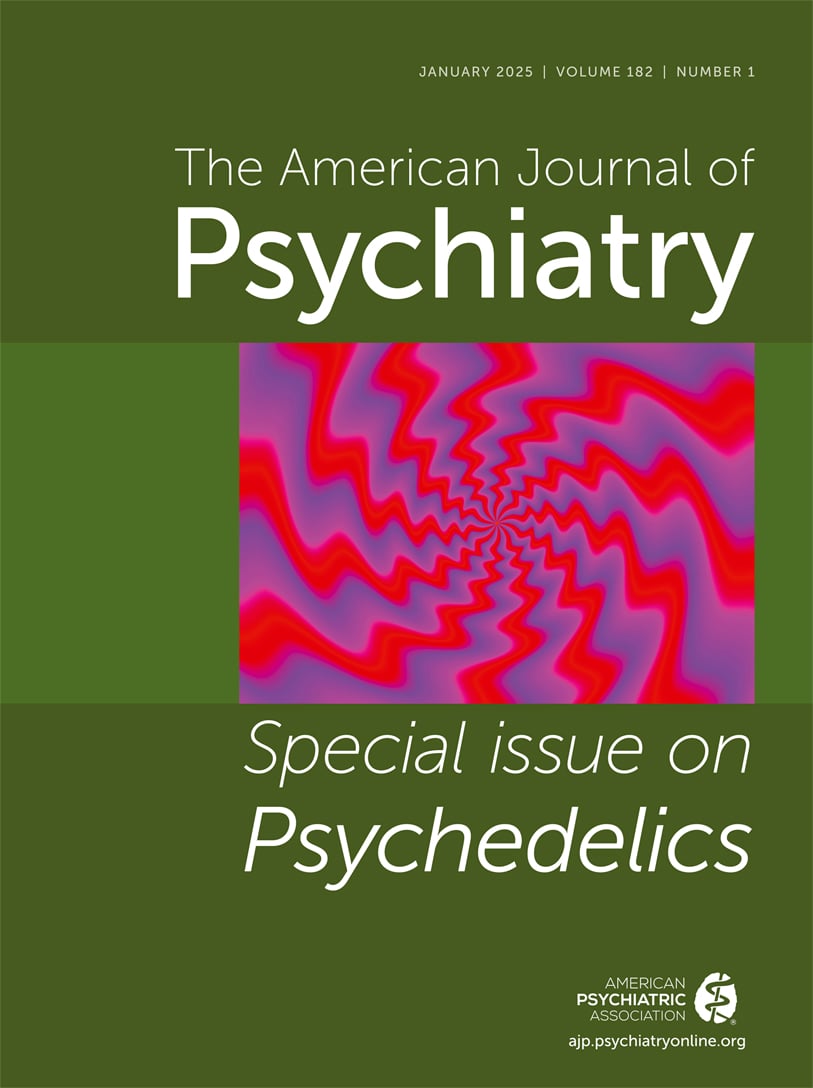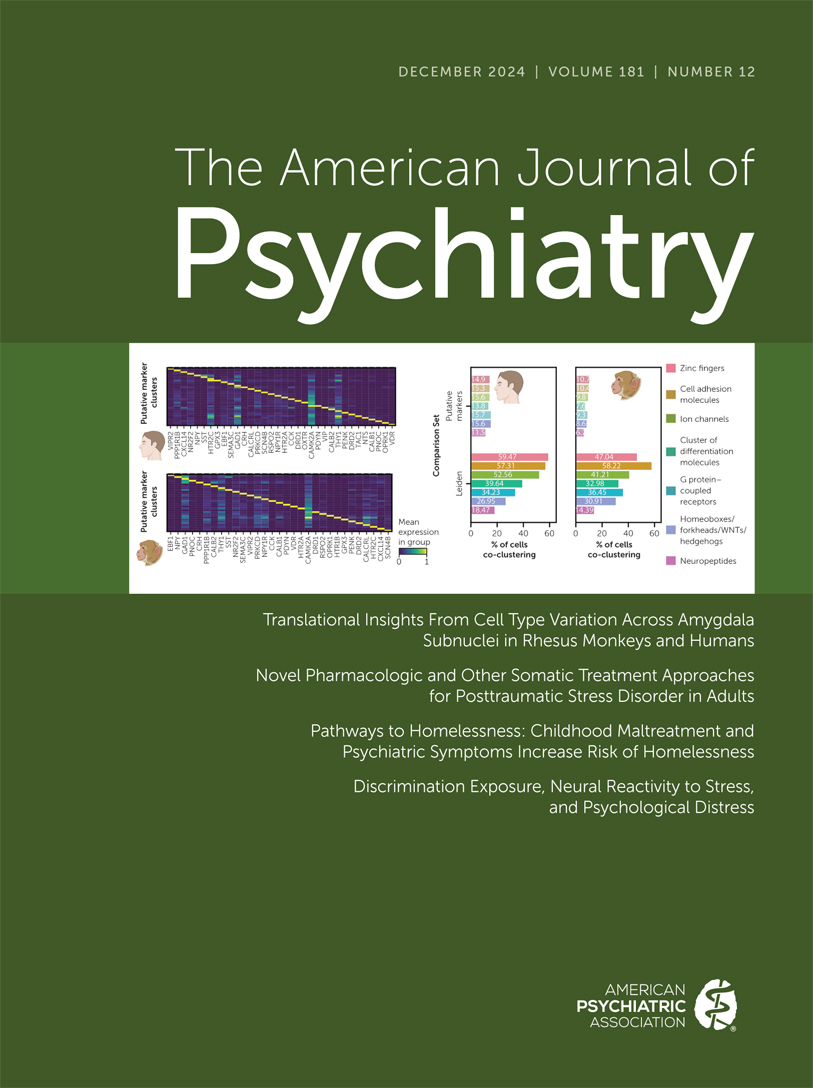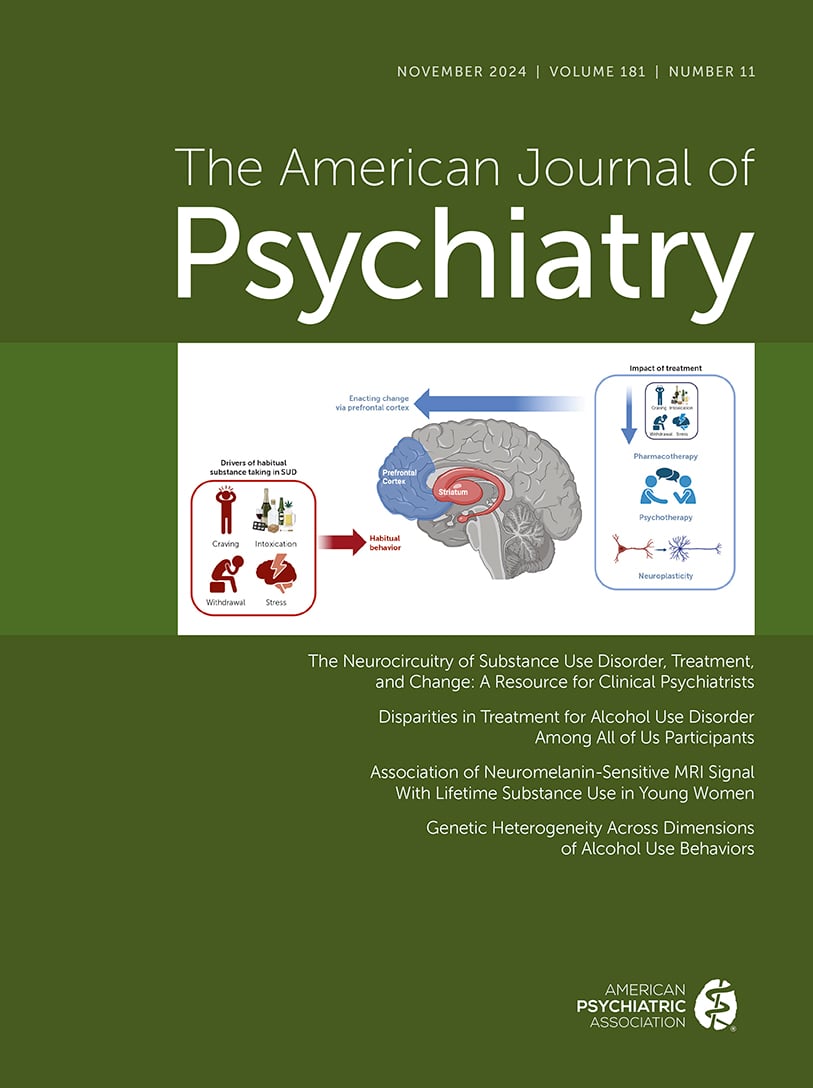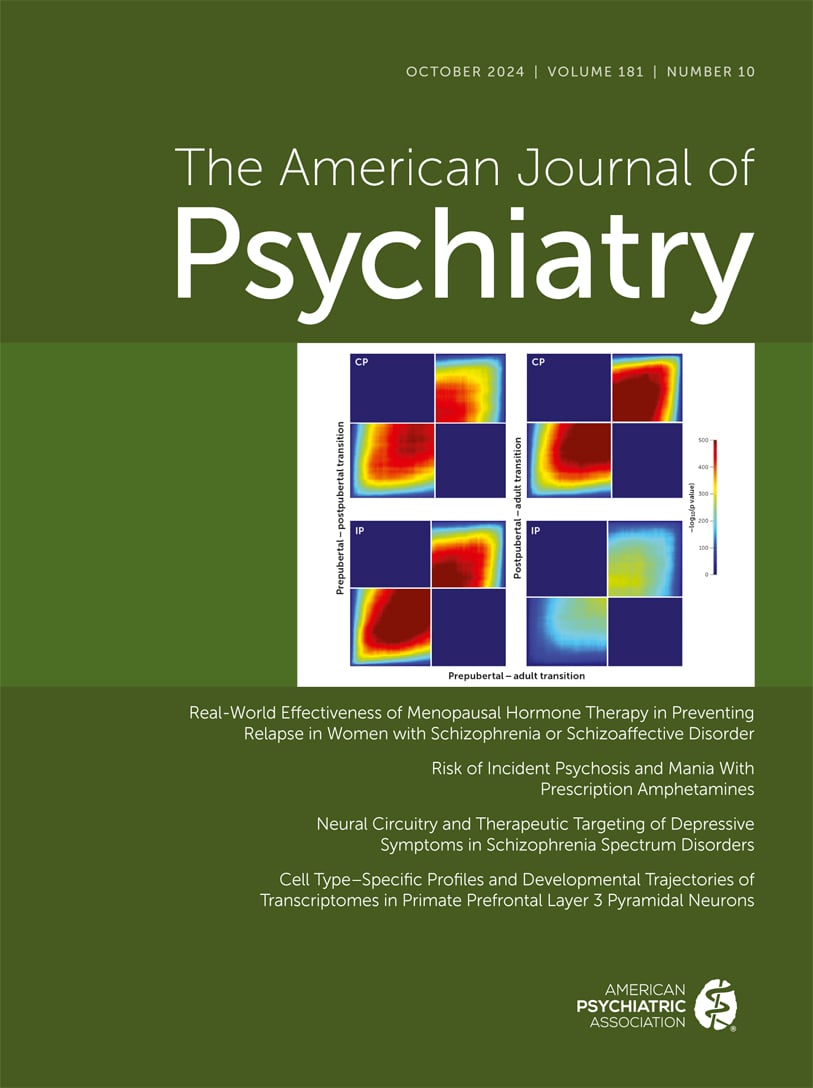American Journal of Psychiatry
- Volume 152
- Number 1
- January 1995
Article
Publication date: 01 January 1995
Pages6–15OBJECTIVE: Neuropsychological test data are applied with increasing frequency in research studies and clinical practice in psychiatry. This article addresses three popular assumptions about neuropsychological test data and describes the limitations and ...
https://doi.org/10.1176/ajp.152.1.6Publication date: 01 January 1995
Pages16–21OBJECTIVE: Homosexuality has remained a focus of military concern despite society's increasing acceptance of homosexual men and women and evidence that homosexuals have served and currently serve in the U.S. armed forces. President Clinton has stated a ...
https://doi.org/10.1176/ajp.152.1.16Publication date: 01 January 1995
Pages22–30OBJECTIVE: This study sought to determine whether a set of symptoms interpreted as complicated grief could be identified and distinguished from bereavement-related depression and whether the presence of complicated grief would predict enduring functional ...
https://doi.org/10.1176/ajp.152.1.22Publication date: 01 January 1995
Pages31–36OBJECTIVE: The authors assessed the frequency of atypical depression in depressed outpatients and compared clinical and biological features of patients with atypical and nonatypical depression. METHOD: Depressed outpatients (N = 114) were diagnosed with ...
https://doi.org/10.1176/ajp.152.1.31Publication date: 01 January 1995
Pages37–44OBJECTIVE: The purpose of this study was to examine the prevalence, risk factors, and correlates of depression among patients with Alzheimer's disease. METHOD: A consecutive series of 103 patients with probable Alzheimer's disease were examined with a ...
https://doi.org/10.1176/ajp.152.1.37Publication date: 01 January 1995
Pages45–52OBJECTIVE: This study compared the severity of and the change in depressive symptoms among men with alcohol dependence, affective disorder, or both disorders during 4 weeks of inpatient treatment. METHOD: After their primary and secondary psychiatric ...
https://doi.org/10.1176/ajp.152.1.45Publication date: 01 January 1995
Pages53–59OBJECTIVE: The authors determined 1) cognitive functioning in detoxified alcoholics who had alcohol-related problems for a relatively brief time and 2) relationships between neuropsychological test scores and recent and chronic alcohol consumption ...
https://doi.org/10.1176/ajp.152.1.53Publication date: 01 January 1995
Pages60–63OBJECTIVE: The literature on the prevalence and importance of hypokalemia in persons with eating disorders in contradictory and confusing. The authors investigated the frequency of hypokalemia and its relationship to symptoms in a group of outpatients ...
https://doi.org/10.1176/ajp.152.1.60Publication date: 01 January 1995
Pages64–71OBJECTIVE: The authors explored the epidemiologic characteristics and risk factors of anorexia nervosa and examined the relationship between narrowly defined anorexia nervosa and anorexia-like syndromes. METHOD: Structured interviews were administered to ...
https://doi.org/10.1176/ajp.152.1.64Publication date: 01 January 1995
Pages72–75OBJECTIVE: The present study sought to determine the prevalence of obsessive-compulsive disorder among patients with eating disorders. METHOD: Ninety-three women who met DSM-III-R criteria for anorexia nervosa or bulimia nervosa were investigated by using ...
https://doi.org/10.1176/ajp.152.1.72Publication date: 01 January 1995
Pages76–84OBJECTIVE: The goal of this study was to determine 1) whether obsessive- compulsive disorder is familial, 2) whether there is a familial relationship between obsessive-compulsive disorder and Gilles de la Tourette's syndrome and chronic tics, and 3) ...
https://doi.org/10.1176/ajp.152.1.76Publication date: 01 January 1995
Pages85–89OBJECTIVE: The DSM-III-R anxiety disorders section includes both panic disorder and obsessive-compulsive disorder. To evaluate the relationship between these two disorders, subject responses to inhalation of a 35% CO2 and 65% O2 mixture were assessed. ...
https://doi.org/10.1176/ajp.152.1.85Publication date: 01 January 1995
Pages90–96OBJECTIVE: Three issues relevant to revising the DSM-III-R criteria for obsessive-compulsive disorder were examined in a field trial: 1) the requirement that symptoms of obsessive-compulsive disorder be viewed by the patient as excessive or unreasonable, ...
https://doi.org/10.1176/ajp.152.1.90Publication date: 01 January 1995
Pages97–101OBJECTIVE: The purpose of this study was to evaluate for APA a proposed strategy to diagnose somatization disorder for possible inclusion in DSM-IV. METHOD: Five sites--Washington University, University of Kansas, University of Iowa, University of ...
https://doi.org/10.1176/ajp.152.1.97Publication date: 01 January 1995
Pages102–109OBJECTIVE: Data from the National Vietnam Veterans Readjustment Study, conducted from 1986 to 1988, were used to develop an etiological model of attempted suicide among a community sample of 1,198 male Vietnam veterans. METHODS: In a three-step process, ...
https://doi.org/10.1176/ajp.152.1.102Publication date: 01 January 1995
Pages110–115OBJECTIVE: Sleep disturbances are important features of posttraumatic stress disorder (PTSD); however, the published data characterizing PTSD sleep phenomena are limited. The authors report on the phenomenology and physiological correlates of symptomatic ...
https://doi.org/10.1176/ajp.152.1.110Publication date: 01 January 1995
Pages116–120OBJECTIVE: This study investigated hypotheses concerning the importance of symptoms of numbing in posttraumatic stress disorder (PTSD). METHODS: Symptoms of PTSD were assessed in 72 female rape victims and 86 female victims of nonsexual assault ...
https://doi.org/10.1176/ajp.152.1.116Article
Publication date: 01 January 1995
Pages122–125OBJECTIVE: The authors' goal was to determine whether fluoxetine is associated with extrapyramidal side effects. METHOD: They assessed the notifications of extrapyramidal manifestations in patients given fluoxetine in the New Zealand Intensive Medicines ...
https://doi.org/10.1176/ajp.152.1.122Publication date: 01 January 1995
Pages126–129OBJECTIVE: The authors examined whether there are abnormalities in high- energy phosphorous metabolism in the basal ganglia of schizophrenic patients. METHOD: In vivo 31P magnetic resonance spectroscopic imaging was performed on 18 chronic schizophrenic ...
https://doi.org/10.1176/ajp.152.1.126Publication date: 01 January 1995
Pages130–134OBJECTIVE: The authors assessed the effects on primary negative symptoms of low doses of amisulpride, a substituted benzamide neuroleptic with high affinity for D2 and D3 dopamine receptors. METHOD: Young, drug-free schizophrenic patients with pure ...
https://doi.org/10.1176/ajp.152.1.130Publication date: 01 January 1995
Pages134–136OBJECTIVE: Involvement of genetic factors in the pathogenesis of schizophrenia spectrum disorders has been indicated in twin, adoption, and familial aggregation studies; the pivotal role played by the dopamine transporter in dopaminergic neurotransmission ...
https://doi.org/10.1176/ajp.152.1.134Publication date: 01 January 1995
Pages137–139OBJECTIVE: The authors investigated a broad range of memory functions for stimuli unrelated to trauma to determine whether symptoms such as intrusive memories might reflect an underlying cognitive deficit unrelated to the psychological content of the ...
https://doi.org/10.1176/ajp.152.1.137Article
Article
Article
Past Issues
View Issues Archive
Vol. 182 | No. 1

Vol. 181 | No. 12

Vol. 181 | No. 11
